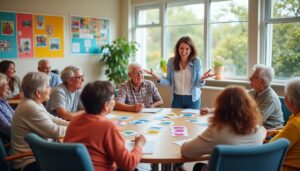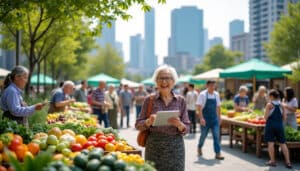We use cookies and data to provide and maintain our services.
They allow us to monitor interruptions and protect us against spam, fraud, and abuse.
By measuring public engagement and website statistics, we better understand the use of our services and improve their quality.
By choosing “Accept all”, you also allow us to develop and improve new services, distribute and measure the effectiveness of advertisements. We can display personalized content and ads tailored to your settings. If you choose “Reject all”, we will not use cookies for these additional purposes. Non-personalized content or non-targeted ads are influenced by the content you are currently viewing and your general location.

With the significant increase in life expectancy and decreasing birth rates, many countries are facing an aging population. This demographic phenomenon is profoundly transforming economic and social dynamics, opening new opportunities for businesses and markets. Understanding this consumption potential is essential to grasp the ongoing changes and anticipate the future needs of seniors.
How does aging influence consumption habits?
The aging population is changing the priorities and purchasing behaviors of elderly individuals. Unlike previous generations, today’s seniors are more active, technologically savvy, and seek products and services that enhance their quality of life. They invest more in health, wellness, leisure, and assisted technologies. For example, the demand for innovative medical devices, teleassistance services, and home comfort solutions is constantly increasing.
Moreover, seniors are increasingly aware of their purchasing power and spending capacity. They seek personalized products that meet their specific needs, whether it be adapted clothing, organized travel, or ongoing education. This evolution pushes companies to adapt their offerings to better target this growing demographic.
Which sectors benefit the most from demographic aging?
Several sectors directly benefit from the aging population. The health sector is one of the most impacted, with increased demand for medical care, rehabilitation services, and pharmaceutical products. Companies are heavily investing in research and development to meet the specific needs of older adults.
The real estate sector is also seeing a transformation, with a rising demand for adapted housing, such as senior residences, which offer integrated care services and suitable infrastructure. Additionally, the market for smart home equipment is experiencing rapid expansion, thanks to the adoption of technologies that facilitate the independence of seniors.
Another booming sector is leisure and tourism. Seniors represent a loyal customer base willing to spend on quality experiences. Customized tourist destinations, tailored cruises, and cultural activities specifically designed for seniors are gaining popularity.
For a deeper analysis of the silver economy, check out this article on The Silver Economy: a potential asset in addressing the aging of the Chinese population.
What technological innovations address the needs of seniors?
Technological advancements play a crucial role in improving the quality of life for elderly individuals. Connected health technologies, such as medical monitoring devices and medication management applications, enable seniors to better manage their health on a daily basis. Smart homes equipped with sensors and automated systems provide greater independence and enhanced security.
Teleassistance platforms and telemedical consultation services have also gained in popularity, facilitating access to care without the necessity of traveling. Moreover, virtual and augmented reality technologies are being used to offer recreational and therapeutic activities, helping to keep the mind active and reduce social isolation.
Innovations in adapted transportation are allowing seniors to move more easily and safely. Autonomous vehicles and shared mobility services specifically designed for seniors represent a promising future for elderly independence.
To discover the latest research on healthy aging, visit This article on King’s College London researchers sharing their work.
What challenges need to be overcome to tap into this consumption potential?
Tapping into the consumption potential related to the aging population comes with several challenges. One of the main ones is ensuring accessibility and inclusion of seniors in the digital economy. It is essential to design intuitive and easy-to-use products and services, suited to the varied technological capabilities of older adults.
Another challenge lies in the need to train professionals on the specificities of this market. Companies must raise awareness among their teams about the unique needs of seniors and develop specific skills to better serve them. This includes a better understanding of the preferences, purchasing behaviors, and expectations of elderly customers.
The issue of privacy and data protection is also crucial. Seniors are often vulnerable to privacy breaches, which emphasizes the importance of implementing robust measures to secure their personal information. Companies must strictly comply with data protection regulations and establish a trust relationship with their clients.
Finally, it is essential to promote a positive image of aging to avoid stereotypes and value seniors as active and influential consumers. An approach centered on respect and autonomy can encourage better acceptance and integration of products and services aimed at seniors.
How do public policies support this market segment?
Public policies play a decisive role in supporting and developing the seniors market segment. Many governments are implementing initiatives to encourage innovation and investment in sectors dedicated to older adults. This includes subsidies for companies developing health technologies, tax incentives for investments in adapted housing, and training programs for professionals working with seniors.
Public health policies also focus on the prevention and well-being of seniors, promoting healthy lifestyles and facilitating access to care. Awareness campaigns are carried out to inform citizens about available resources and encourage them to adopt behaviors favorable to active aging.
Furthermore, some regions are implementing legislative frameworks to protect the rights of seniors and ensure their social and economic inclusion. For example, laws on the accessibility of public spaces and public transportation aim to facilitate the mobility of elderly individuals, thus promoting their active participation in economic and social life.
To learn more about the importance of benefits programs for seniors, check out This article on the perspectives of the National Council on Aging.
What is the importance of research and market studies in this field?
Research and market studies are essential for understanding the specific dynamics of the aging population and identifying consumption opportunities. They allow the collection of valuable data on the preferences, needs, and behaviors of seniors, thus providing strategic insights to businesses.
Market studies help segment the elderly population into different categories based on criteria such as age, health level, income, and interests. This segmentation facilitates the personalization of offerings and the development of targeted marketing strategies, maximizing impact and customer satisfaction.
Moreover, research contributes to innovation by identifying still untapped market niches and anticipating future needs. Businesses can thus develop innovative products and services, adapted to the evolving expectations of seniors and position themselves as leaders in this growing market segment.
To discover captivating stories about aging in China, check out This article about a new life at every age in China.
What are the benefits of a senior-centered approach?
Adopting a senior-centered approach presents numerous advantages for businesses and society as a whole. By focusing on the specific needs of older individuals, companies can build stronger, more durable relationships with their clients. This fosters loyalty and satisfaction, two key elements for long-term success.
Such an approach also encourages innovation and differentiation in the market. By developing tailored solutions, companies can stand out from the competition and attract a loyal customer base. Furthermore, it opens the door to new business opportunities and expansion into niche markets.
From a social standpoint, particular attention to seniors contributes to improving their quality of life and promoting an inclusive society. It allows for recognizing and valuing the role of older adults by providing them with resources and services that meet their specific needs. In return, this reinforces the social fabric and encourages greater intergenerational cohesion.
Finally, by investing in this market segment, companies actively participate in creating a sustainable and resilient economy, capable of adapting to demographic changes and addressing future challenges.








